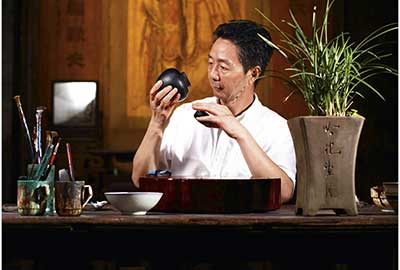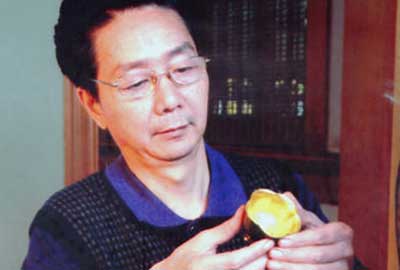Non-genetic inheritors are willing to "paint" colorful life

Lacquerware is an important invention in chemical technology and arts and crafts in ancient China. Since the Neolithic Age, ancestors have known the performance of lacquer and used it to make utensils. Huizhou was famous for its lacquerware as early as the Tang Dynasty. In the Song Dynasty, Huizhou’s fine inlaid Luodian lacquerware was famous all over the country, and it was known as "Song inlaid". Huizhou is rich in lacquer trees. Huizhou lacquerware is made of natural raw lacquer as the main raw material, mixed with turquoise, cinnabar, coral, blue veins and cinnabar, etc., and is called "pineapple lacquerware" in ancient times. Pineapple lacquerware is the highest level representative of Huizhou lacquerware technology. However, this excellent traditional craft is also facing loss.
Gan Keke was born in Huang Shanren, Anhui Province in 1955. Willing to understand painting, good at carpentry, carving and fine design, lacquer art follows pure traditional techniques. After nearly 30 years of continuous exploration, innovation and practice, he revived the traditional Huizhou lacquering techniques "pineapple lacquer" (also known as rhinoceros skin lacquer) and "lacquered sand inkstone", which were on the verge of extinction, and revived their vitality, so he was named as the national inheritor of Huizhou lacquering techniques.
Gan Keke has perfected Huizhou lacquerware. His round box of "pineapple lacquer" is one of the four works of modern people collected by the Palace Museum in China. But he always said to people, "I am an old painter." "Historical Records" says that "the middle of the day will move, and the full moon will lose money." I am willing to say, "If I don’t be the first, I will be the old Huizhou lacquer. Nothing is perfect. The first is too perfect, and perfect things can’t be done." Gan said this, but he didn’t do it. He has reached the peak of Huizhou lacquerware.

Gan Keke began to learn carpentry after graduating from junior high school, and also studied painting and sculpture. Later, he made wooden models in Tunxi Log Club. Ten years of woodworking experience laid a solid foundation for his design and sculpture. In 1979, only 24-year-old Gan Erke entered Tunxi Lacquerware Craft Factory in Anhui Province, and first studied sculpture with the old artists in the factory. Because of his intelligence, high understanding, and good artistic skills, he made great progress in carving art. The next year, the factory sent him to Shanghai Arts and Crafts No.6 Factory to learn lacquer carving technology.
After returning from his studies in Shanghai, Gan Keke was promoted as the workshop director of the lacquer carving workshop. During this period, he had the opportunity to get in touch with Yu Jinhai, a lacquerware artist in Tunxi who was known as the "national hand of Chu lacquer" at that time. Because he likes diamonds and can bear hardships, most of Yu Jinhai’s lacquerware works are carved by him, and gradually he has mastered the essentials of lacquerware making.
In 1985, Gan Keke was transferred to Tunxi Arts and Crafts Institute, where he began to contact bodiless lacquerware. Ordinary lacquerware is made of wood, leather, metal, etc., and then painted with raw lacquer, while bodiless lacquerware is made of clay, gypsum, etc., and the carcass is removed after painted with raw lacquer, so bodiless lacquerware is more difficult and the process is more complicated. In Tunxi Arts and Crafts Institute, there are more people who are willing to contact, and their horizons are broader. From design, sculpture, production to lighting, he has integrated various techniques of lacquer making and laid a solid foundation.
In order to better inherit Huizhou lacquer craft, Gan Keke took seven students. Now they have been able to operate independently and use various lacquer making techniques flexibly, which can help Gan Keke make lacquerware, but even so, they can only make a dozen or twenty pieces a year. Although some people advised him to take advantage of the good market, he didn’t have to do it himself, and processed a batch and put it on the market. But he is willing to say: "Although money is good, but the mentality can’t be chaotic, people will be reflected in their works when they are impetuous. All my things must be excellent, and they must be kept and passed on. There are many kinds of traditional lacquer crafts in Huizhou. I want to calm down and restore them. I want people to see the brilliance of Huizhou lacquerware again through my hands. "

Ganerke has always been rooted in the tradition of lacquer art in China, and its raw materials and technology adhere to the ancient principles of making natural lacquer. Explore the greatest possibility of deepening the development of fine and elegant lacquer art technology, and push the deep essence of China lacquer art field and the representatives of rhinoceros skin paint, push-gloss paint, lacquer sand inkstone and fine lacquer surface decoration with emblem characteristics to a new height of inheriting tradition in China.
Gan Keke likes to put his philosophy of life into the process of making lacquerware, which proves each other, which makes his daily manual work seem to have a taste of self-meditation. He takes a fancy to the "degree" of doing things and being a man, and also to the creed of "being gentle as jade". In the eyes of people around him, the sweetness of life is extremely strict with the requirements of craftsmanship without any relaxation. However, he has always been gentle, moderate in words and deeds, not angry with others and rarely anxious. It is quite a gentleman’s wind-polishing his own temperament is just like polishing a beloved lacquer.